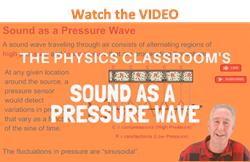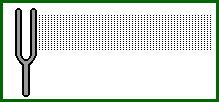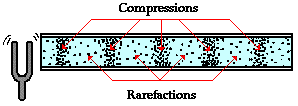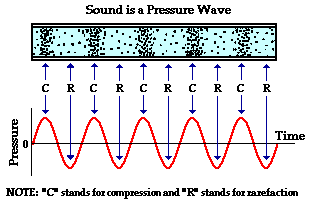Hold down the T key for 3 seconds to activate the audio accessibility mode, at which point you can click the K key to pause and resume audio. Useful for the Check Your Understanding and See Answers.
 Sound is a mechanical wave that results from the back and forth vibration of the particles of the medium through which the sound wave is moving. If a sound wave is moving from left to right through air, then particles of air will be displaced both rightward and leftward as the energy of the sound wave passes through it. The motion of the particles is parallel (and anti-parallel) to the direction of the energy transport. This is what characterizes sound waves in air as longitudinal waves.
Sound is a mechanical wave that results from the back and forth vibration of the particles of the medium through which the sound wave is moving. If a sound wave is moving from left to right through air, then particles of air will be displaced both rightward and leftward as the energy of the sound wave passes through it. The motion of the particles is parallel (and anti-parallel) to the direction of the energy transport. This is what characterizes sound waves in air as longitudinal waves.
Compressions and Rarefactions
A vibrating tuning fork is capable of creating such a longitudinal wave. As the tines of the fork vibrate back and forth, they push on neighboring air particles. The forward motion of a tine pushes air molecules horizontally to the right and the backward retraction of the tine creates a low-pressure area allowing the air particles to move back to the left.

Because of the longitudinal motion of the air particles, there are regions in the air where the air particles are compressed together and other regions where the air particles are spread apart. These regions are known as compressions and rarefactions respectively. The compressions are regions of high air pressure while the rarefactions are regions of low air pressure. The diagram below depicts a sound wave created by a tuning fork and propagated through the air in an open tube. The compressions and rarefactions are labeled.

The wavelength of a wave is merely the distance that a disturbance travels along the medium in one complete wave cycle. Since a wave repeats its pattern once every wave cycle, the wavelength is sometimes referred to as the length of the repeating patterns - the length of one complete wave. For a transverse wave, this length is commonly measured from one wave crest to the next adjacent wave crest or from one wave trough to the next adjacent wave trough. Since a longitudinal wave does not contain crests and troughs, its wavelength must be measured differently. A longitudinal wave consists of a repeating pattern of compressions and rarefactions. Thus, the wavelength is commonly measured as the distance from one compression to the next adjacent compression or the distance from one rarefaction to the next adjacent rarefaction.
What is a Pressure Wave?
Since a sound wave consists of a repeating pattern of high-pressure and low-pressure regions moving through a medium, it is sometimes referred to as a pressure wave. If a detector, whether it is the human ear or a man-made instrument, were used to detect a sound wave, it would detect fluctuations in pressure as the sound wave impinges upon the detecting device. At one instant in time, the detector would detect a high pressure; this would correspond to the arrival of a compression at the detector site. At the next instant in time, the detector might detect normal pressure. And then finally a low pressure would be detected, corresponding to the arrival of a rarefaction at the detector site. The fluctuations in pressure as detected by the detector occur at periodic and regular time intervals. In fact, a plot of pressure versus time would appear as a sine curve. The peak points of the sine curve correspond to compressions; the low points correspond to rarefactions; and the "zero points" correspond to the pressure that the air would have if there were no disturbance moving through it. The diagram below depicts the correspondence between the longitudinal nature of a sound wave in air and the pressure-time fluctuations that it creates at a fixed detector location.

The above diagram can be somewhat misleading if you are not careful. The representation of sound by a sine wave is merely an attempt to illustrate the sinusoidal nature of the pressure-time fluctuations. Do not conclude that sound is a transverse wave that has crests and troughs. Sound waves traveling through air are indeed longitudinal waves with compressions and rarefactions. As sound passes through air (or any fluid medium), the particles of air do not vibrate in a transverse manner. Do not be misled - sound waves traveling through air are longitudinal waves.

We Would Like to Suggest ...

Why just read about it and when you could be interacting with it? Interact - that's exactly what you do when you use one of The Physics Classroom's Interactives. We would like to suggest that you combine the reading of this page with the use of our
Simple Wave Simulator. You can find it in the Physics Interactives section of our website. The
Simple Wave Simulator provides the learner an environment to explore the distinction between longitudinal and transverse waves, the wavelength-frequency-period relationship, sound waves as pressure waves, and much more.
Check Your Understanding
1. A sound wave is a pressure wave; regions of high (compressions) and low pressure (rarefactions) are established as the result of the vibrations of the sound source. These compressions and rarefactions result because sound
a. is more dense than air and thus has more inertia, causing the bunching up of sound.
b. waves have a speed that is dependent only upon the properties of the medium.
c. is like all waves; it is able to bend into the regions of space behind obstacles.
d. is able to reflect off fixed ends and interfere with incident waves
e. vibrates longitudinally; the longitudinal movement of air produces pressure fluctuations.